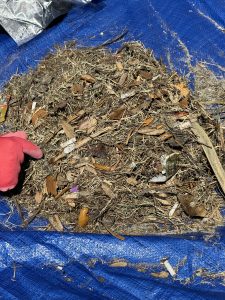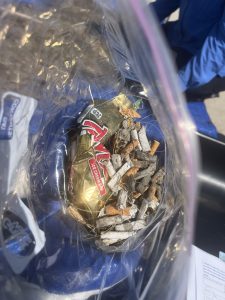One of the most common items found during litter cleanups are cigarette butts. They were the number one debris item picked up over the past 25 years during the Ocean Conservancy’s International Coastal Cleanup. In 2022 alone, the Ocean Conservancy reported 1,860,651 cigarette butts collected worldwide. Cigarette butts constitute nearly 20% of all litter. They are often discarded into the environment and carried off with runoff from the streets to drains, to rivers, and then ultimately end up in our waterways and beaches.
Cigarette Butts are NOT biodegradable

There is a common misconception that cigarette butts are biodegradable, however, they are NOT biodegradable. This misconception makes most people believe that they are not littering or harming the environment when they toss their cigarette butts on the ground. A study by Rath et al. (2012) states that the majority (74.1%) of smokers reported having littered cigarette butts at least once in their life, by disposing of them on the ground or throwing them out of a car window. Cigarette butts not only contain numerous toxic compounds that can leach into the water, but they are also made of a plastic called cellulose acetate. The plastic breaks into smaller pieces but does not biodegrade. Hence, they contribute to the amount of plastic entering our waterways each year. Once they make their way to the water, cigarette butts can float for long periods before becoming saturated with water and sinking, making them available to animals to ingest. Cigarette butts have been found in the stomach contents of animals, such as fish, birds, turtles, and whales, that accidentally mistake them for food. Besides the obstruction to their gastrointestinal tracts the chemicals that are leached from cigarette butts are absorbed into the animals organs. Exposure to these chemicals can have negative effects on the survival, growth, and reproduction of aquatic organisms (Dobardaran, et al. 2021).
So how do we tackle this issue?
- Educate people and let them know that cigarette butts are not biodegradable,
- Encourage proper disposal of cigarette butts by installing more cigarette receptacles, and
- Install devices, such as storm drain traps, to capture litter, including cigarette butts, at the source.


Operation TRAP is doing just that. As of May, we have installed 4 litter interceptor devices in Cedar Key, FL. With these devices, we are keeping cigarette butts out of our Aquatic Preserves. In just one storm drain trap located on Cedar Key’s C Street bridge, we have already prevented 153 cigarette butts from entering our waterways. We will be installing 30-35 traps in Cedar Key and Pasco County as the project continues. This is where we need your help! Volunteers are needed to clean out, organize, and analyze the amount of litter captured by our devices. Sign up to help here. All volunteers will be trained and supplied with the tools necessary to perform the cleanups. If you have any questions, please do not hesitate to email Monica Wilson at monicawilson447@ufl.edu
Operation TRAP is supported by NOAA’s Marine Debris Program with funding provided by the Bipartisan Infrastructure Law and in partnership with FDEP’s Aquatic Preserves, Florida Sea Grant, Pasco County, Keep Pasco Beautiful, and the City of Cedar Key.
Dobaradaran, S., Soleimani, F., Akhbarizadeh, R., Schmidt, T. C., Marzban, M., & BasirianJahromi, R. (2021). Environmental fate of cigarette butts and their toxicity to aquatic organisms: A comprehensive systematic review. Environmental Research, 195.
Rath, J. M., Rubenstein, R. A., Curry, L. E., Shank, S. E., & Cartwright, J. C. (2012). Cigarette Litter: Smokers’ Attitudes and Behaviors. International journal of Environmental Research and public Health, 9, 2189-2203.
 2
2
